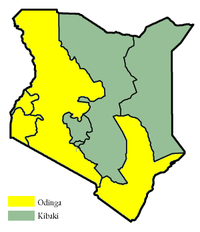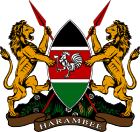
A | B | C | D | E | F | G | H | CH | I | J | K | L | M | N | O | P | Q | R | S | T | U | V | W | X | Y | Z | 0 | 1 | 2 | 3 | 4 | 5 | 6 | 7 | 8 | 9
| |||||||||||||||||||||
|
| |||||||||||||||||||||
Presidential election | |||||||||||||||||||||
| |||||||||||||||||||||
 Presidential election results map. Green denotes provinces won by Kibaki, and Yellow denotes those won by Odinga. | |||||||||||||||||||||
| |||||||||||||||||||||
 |
|---|
|
|
General elections were held in Kenya on 27 December 2007.[1] Voters elected the President, and members of the National Assembly. They coincided with the 2007 Kenyan local elections.
Incumbent Mwai Kibaki, running on a Party of National Unity (PNU) ticket, defeated Raila Odinga, leader of the Orange Democratic Movement (ODM) and Kalonzo Musyoka of Orange Democratic Movement–Kenya. The elections were strongly marked by ethnic hostility, with Kibaki a member of the traditionally dominant Kikuyu ethnic group, gaining much support amongst the Kikuyu and neighbouring groups in central Kenya, including the Embu and Meru. Odinga, as a member of the Luo ethnic group, succeeded in creating a wider base by building a coalition with regional leaders from the Luhya in Western Kenya, Kalenjin from the Rift Valley and Muslim leaders from the Coast Province. Kibaki was declared the winner with 46% of the vote, and was sworn in at State House on 30 December. However, opposition leader Raila Odinga also claimed victory,[2][3] and civil unrest broke out resulting in the deaths of several hundred people and the displacement of up to 600,000. This was ended by the National Accord and Reconciliation Act, which led to Odinga being appointed as Prime Minister.
In the National Assembly elections, the ODM won 99 of the 208 seats, with the PNU finishing second with 43 seats. The Kenya African National Union, which had ruled the country from independence until 2002 was reduced to being the fourth-largest party with only 15 seats. Only 71 of the 190 sitting MPs were re-elected, twenty ministers lost their seats and a record 15 female MPs were elected.[4]
There is agreement in the international community that the presidential elections were at least partially manipulated.[5] In July 2008, an exit poll commissioned by the US was released, suggested that Odinga was predicted to have won the presidency by a comfortable margin of 6%, 46% to 40%, well outside the exit poll's 1.3% margin of error.[6]
Background
Presidential candidates
Incumbent president Mwai Kibaki declared his intention to run for re-election on 26 January 2007, although he had previously declared prior to the 2002 elections that he needed only one term as president.[7] On 16 September 2007, Kibaki announced that he would run as the candidate of a new alliance called the Party of National Unity, which would include a number of parties, including KANU,[8][9] the Democratic Party, NARC–Kenya, FORD-Kenya, Ford–People and Shirikisho among others.[9]
The Orange Democratic Movement–Kenya (ODM–Kenya) alliance was expected to field the strongest challenger to Kibaki; the main parties originally affiliated to ODM–Kenya were the Liberal Democratic Party (LDP) and KANU.[10] At the time of the 2002 elections, the LDP had been part of the National Rainbow Coalition (NARC) movement backing Kibaki, but its ministers were dismissed from the cabinet after the 2005 constitutional referendum.[11] KANU and LDP had originally teamed up for the 2005 referendum under the banner Orange Democratic Movement,[12] but former president Daniel arap Moi was among the KANU faction opposing involvement with the ODM–Kenya coalition.[13] As a result, ODM–Kenya split in two in August 2007, one remaining as ODM–Kenya and led by Kalonzo Musyoka, the other going by the name Orange Democratic Movement (ODM). KANU subsequently left the coalition entirely, and Moi announced his support for Kibaki, his former political enemy, in late August.[14] Uhuru Kenyatta followed suit and announced his support for Kibaki in mid-September. KANU did not nominate as presidential candidate, although it contested the National Assembly elections.[15]
Several ODM members vied for presidency, including Musyoka, Raila Odinga, Kenyatta (before KANU's withdrawal), William Ruto, Najib Balala, Musalia Mudavadi and Joseph Nyagah.[16] Following the August 2007 split, ODM–Kenya appointed Musyoka as its candidate on 31 August and the ODM selected Odinga as its candidate on 1 September.[17][18][19]
Presidential candidates presented their nomination papers on 14 and 15 November to the Electoral Commission of Kenya (ECK) and nine candidates were cleared to be on the ballot in December.[20] All nine presidential candidates also ran for a parliamentary seat as required by Kenyan law; the presidential election winner needed to also win a parliamentary seat to be named president.[21]
National Assembly
The ninth parliament was dissolved on Monday 22 October 2007,[22] with the election date of 27 December announced on 26 October 2007 by the ECK. The ECK initially set a deadline of 19 November 2007 for submitting the candidate lists to prevent candidates from defecting after failing to gain nominations from their parties, but later retracted and allowed defections to minor parties.[23] The ODM, PNU and ODM–K held their primary elections on 16 November, with all three termed as chaotic and being marred by irregularities and violence. Numerous candidates defected to smaller parties after failing to get candidature by their respective parties,[24] including Nobel laureate Wangari Maathai, who failed to gain a PNU nomination, and former Interior Minister Chris Murungaru, who lost out to a little-known trader.[25]
There were 14,296,180 registered voters; 68.8% of the electorate were aged between 18 and 40, with the remaining 31.2% being those over 40.[21]
Zdroj:https://en.wikipedia.org?pojem=2007_Kenyan_parliamentary_election
Text je dostupný za podmienok Creative Commons Attribution/Share-Alike License 3.0 Unported; prípadne za ďalších podmienok. Podrobnejšie informácie nájdete na stránke Podmienky použitia.
Antropológia
Aplikované vedy
Bibliometria
Dejiny vedy
Encyklopédie
Filozofia vedy
Forenzné vedy
Humanitné vedy
Knižničná veda
Kryogenika
Kryptológia
Kulturológia
Literárna veda
Medzidisciplinárne oblasti
Metódy kvantitatívnej analýzy
Metavedy
Metodika
Text je dostupný za podmienok Creative
Commons Attribution/Share-Alike License 3.0 Unported; prípadne za ďalších
podmienok.
Podrobnejšie informácie nájdete na stránke Podmienky
použitia.
www.astronomia.sk | www.biologia.sk | www.botanika.sk | www.dejiny.sk | www.economy.sk | www.elektrotechnika.sk | www.estetika.sk | www.farmakologia.sk | www.filozofia.sk | Fyzika | www.futurologia.sk | www.genetika.sk | www.chemia.sk | www.lingvistika.sk | www.politologia.sk | www.psychologia.sk | www.sexuologia.sk | www.sociologia.sk | www.veda.sk I www.zoologia.sk



